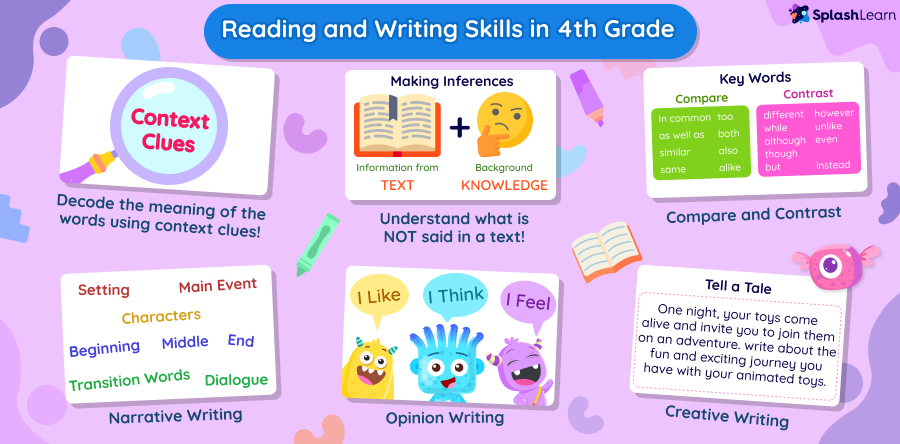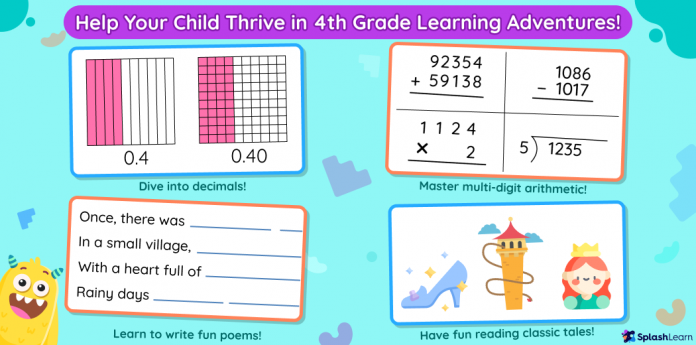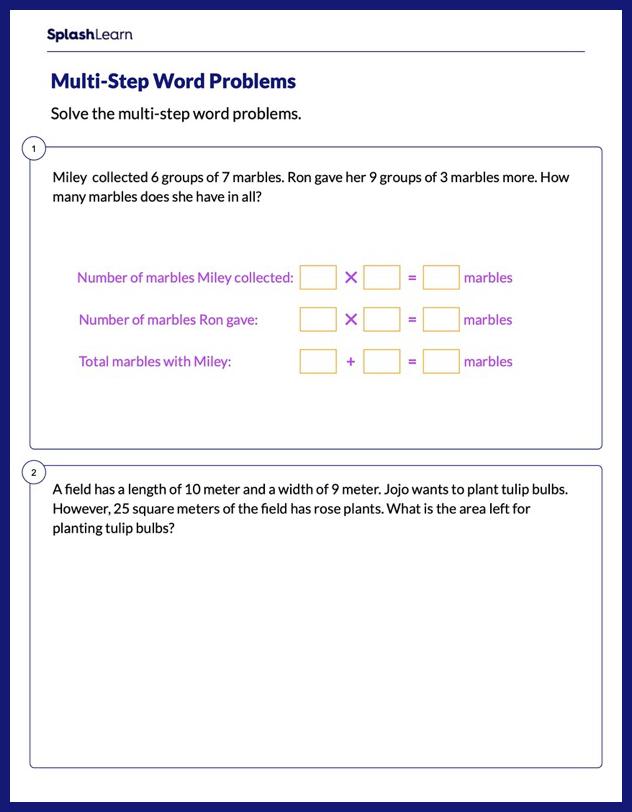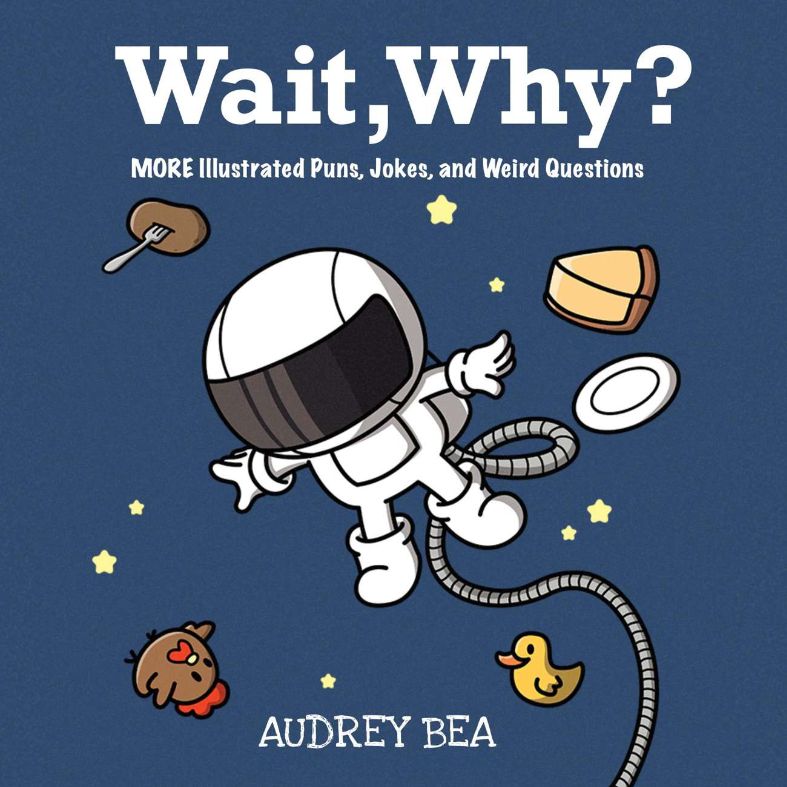Is your kid starting 4th grade? Then by now, they have already gotten the hang of school life and routine. So, it’s time for social skill building and advanced academic training.
Math & ELA | PreK To Grade 5
Kids see fun.
You see real learning outcomes.
Watch your kids fall in love with math & reading through our scientifically designed curriculum.
Parents, try for free Teachers, use for free
What do you learn in 4th grade? This year marks the beginning of upper elementary school, where students delve deeper into math, reading, writing, and science. In this grade, kids build on foundational skills learned in 3rd grade.
Fourth grade will foster your child’s social and academic growth through new activities and lessons. So, to prepare your child for a new grade, you should first understand what is taught to kids in 4th grade. This will help you prepare your 4th grader for a new class.
What Is Taught to Kids in 4th Grade? Key Subjects & Skills
The fourth-grade curriculum for each state and district is slightly different. However, the main lesson structure and subjects in all states are the same. The basic lessons and some crucial things you learn in 4th grade include multiplication, division, decimals, science concepts like the solar system, and reading comprehension.
Now, let’s explore important 4th-grade subjects and skills, along with activities and strategies parents can use to supercharge their child’s learning at home.
Math for 4th Graders
Fourth-grade math will be more complicated and fractional. In third grade, your child has learned all about sequences and patterns. They will learn to find factors and multiples of different numbers in the fourth grade. In addition, your child will learn to subtract fractions and recognize equivalent and non-equivalent fractions by the end of fourth grade.
They will also learn to analyze, collect, organize, and present data. Moreover fourth grade will also teach your children how to convert and calculate different units of measurement.
Here are important math skills kids learn in 4th grade, along with fun learning activities parents can use to reinforce these skills:
- Number Sense
- Identify place values of multi-digit whole numbers.
i) Place Value Spinner: Create a spinner with place values (ones, tens, hundreds, thousands, etc.) and a separate spinner with digits (0-9). Have your child spin each one, place the resulting digit in the corresponding place value, and read out the number created. This helps reinforce the role of each place value.
ii) Interactive Place Value Games: In these games, kids learn place values in multi-digit numbers by working with place value charts, base 10 blocks, and expanded form. They will also learn to build 4-digit numbers with given digits.
Master place values in large numbers!
Begin here
- Compare multi-digit numbers.
i) Write pairs of multi-digit numbers on place value charts (e.g., 3,456 and 3,652). Have your child compare each place value, starting from the highest place value. Encourage them to explain their reasoning as they go.
ii) Here are fun games to practice this activity: Kids will practice solving a set of questions by comparing numbers with up to 6 digits.
Compare numbers using a place value chart!
Related Reading: How to Teach Number Sense
- Arithmetic Operations
- Fluently add and subtract multi-digit whole numbers.
i) Grocery List Addition/Subtraction: Create a pretend grocery list with items and prices in the hundreds and thousands. Have your child “shop” by adding up the total or subtracting certain items from their list to practice multi-digit addition and subtraction in a practical context.
ii) Addition and Subtraction Games: In these games, kids will solve problems using base-10 blocks, column method, horizontal strategy, regrouping, and word problems.
Master multi-digit addition and subtraction!
- Multiply a whole number up to four digits by a one-digit number.
i) Array Creation: Use graph paper to have your child draw an array that represents a four-digit number multiplied by a one-digit number (e.g., 3,000 x 4). They can color in groups to visually understand the multiplication and count to confirm their answer.
ii) Give your child a four-digit number and a one-digit multiplier (e.g., 2,345 x 3). Ask them to break down the four-digit number by place value (e.g., 2,000, 300, 40, and 5), then multiply each part by the one-digit number and add the results. This shows the structure of multi-digit multiplication.
iii) Multiplication Games: In these games, kids will use different strategies, such as long multiplication, area model multiplication, and horizontal multiplication.
Play and master multiplication!
- Divide four-digit dividends by one-digit divisors.
i) Set up a long division problem on paper (e.g., 4,528 ÷ 4). Walk through each step with your child, asking them to divide each part of the number one at a time. Practice with multiple problems to build fluency.
ii) Here are fun games that will guide your child at every step of the long division process: Kids will work with up to 4-digit dividends and 1-digit divisors.
Let’s practice long division!
- Solve multi-step word problems.
i) Real-Life Math Scenarios: Create simple, relatable scenarios that require multiple steps to solve. For example, “You have $20 and buy two snacks that cost $4 each. How much do you have left after buying the snacks?” This involves both multiplication and subtraction. Have your child solve each step one at a time, writing down the answer for each step.
ii) Multi-step Word Problem Worksheets: In these exercises, kids will solve multi-step word problems focusing on four operations, comparison scenarios, and various fun themes.
Let’s solve multi-step word problems!
Related Reading: Best Strategies for Solving Math Word Problems
- Fractions
- Identify and create equivalent fractions.
i) Prepare cards with fractions and their equivalents (e.g., 1/2, 2/4, 3/6, 4/8). Shuffle them and lay them face down. Have your child play a memory game where they flip over two cards at a time, trying to find equivalent fractions. They must explain why the fractions are equivalent to claim the pair.
ii) Equivalent Fraction Games: In these games, kids will learn to recognize and generate equivalent fractions using visual models, number lines, and playful activities.
Play and identify equivalent fractions!
- Compare and order fractions using >, =, or < by finding common denominators and using benchmark fractions.
i) Use fruit or pizza slices divided into fractions (like 1/2, 1/3, and 1/4) and ask, “Which is bigger?” Similarly, you can draw fraction bars on paper for different fractions and use >, =, or < symbols to order them by size. Here are interactive games to practice fraction comparison with real-world models:
Compare fractions using models!
ii) Have your child compare fractions to 1/2 or 1 (e.g., ask, “Is 3/4 closer to 1/2 or 1?”) using paper strips or drawings to visualize the benchmarks. Get started with these engaging games:
Compare fractions easily using benchmark fractions!
iii) Try these games to help kids understand the concept of common denominators. Kids will learn to compare fractions with both like and unlike denominators.
Learn to compare like and unlike fractions!
- Add and subtract fractions with like denominators.
i) Use paper “pizza” slices (cut into 1/4s or 1/8s) to add or remove slices from a whole pizza to practice addition and subtraction.
ii) Fraction Addition and Subtraction Games: In these games, kids will use fraction models, number lines, and also direct strategies to add and subtract fractions and mixed numbers.
Master addition and subtraction of fractions!
- Add and subtract mixed numbers with like denominators.
i) Use a ruler to measure lengths in mixed numbers (like 1 1/4 inches) and add or subtract them to find the total.
ii) Mixed Number Operations Games: In these games, kids will use fraction models, number lines, and direct strategies to add and subtract mixed numbers.
Master addition and subtraction of mixed numbers!
- Compose and decompose fractions.
i) Use Legos or small blocks to create a whole from parts, like four 1/4 blocks, then separate them back into fractions.
ii) Draw a whole square on paper, divide it into fractions (like halves), and shade in parts to show how fractions combine to make a whole.
- Multiply a fraction by a whole number.
i) Set up a snack-time scenario: “Each person gets 1/3 of a sandwich. How many sandwiches do we need for 4 people?”
ii) Draw a rectangle divided into fractions and color in parts to show, for example, what 314 looks like visually.
iii) Fraction Multiplication Games: In these games, kids will multiply fractions with whole numbers using models, number lines, and direct calculations.
Play and multiply fractions with a whole number!
- Solve word problems involving the addition and subtraction of fractions with like denominators and involving multiplication of a fraction by a whole number.
i) Discuss story problems with your child: “If you read 1/2 of a book each day, how much will you have read in 4 days?
ii) Help your child fun word problems on fraction operations using these engaging games:
Learn to solve fraction word problems!
- Decimals
- Understand decimal notation for fractions.
i) Show how fractions like 1/10 or 1/100 convert to decimals (e.g., 1/10 = 0.1) by drawing grids and shading parts.
ii) Reading and Writing Decimals Games: In these games, kids will learn to use models to identify and represent decimals like tenths and hundredths.
Identify and represent decimals!
- Compare decimal fractions. Compare two decimals using >, =, or <.
i) Use a number line and place decimal fractions (e.g., 0.4 and 0.6) to visually compare which is greater.
ii) Decimal Comparison Games: In these games, kids will use place value charts and number lines to compare decimals with ease.
Compare decimal fractions!
- Express a fraction with denominator 10 as an equivalent fraction with denominator 100, and use decimal notation to express these fractions.
i) Use a grid of 100 squares and color in tenths (like 4/10 as 40/100) to illustrate the equivalence visually.
ii) Here are engaging worksheets that help kids identify equivalent decimals:
Identify equivalent decimals!
Related Reading: How to Teach Decimals: A Step-by-Step Guide
V. Measurement and Data
- Solve problems involving measurement and conversion of measurements from a larger unit to a smaller unit.
i) Use a ruler to measure items around the house, converting measurements (e.g., convert 3 feet to inches).
ii) In the kitchen, ask your child to convert larger units to smaller ones while measuring ingredients (e.g., convert 1 quart to cups).
iii) Unit conversion games: In these games, kids will use conversion tables to convert metric and customary units of length, weight, and capacity.
Convert units of measurement!
- Use four operations to solve word problems involving measurement.
i) Create a word problem like, “If a rope is 15 feet and you cut off 4 feet, how much is left?” Practice addition, subtraction, multiplication, and division with measurements.
ii) Discuss questions like—”If each tile is 1 foot wide, how many tiles are needed to cover a 12-foot floor?”—Practice multiplication and division.
- Represent and interpret data.
i) Have your child collect data, like how many books each family member read, and make a bar chart.
ii) Track the daily temperature and create a line graph to show temperature changes over a week.
- Solve problems using information presented in line plots.
i) Measure various objects in inches and create a line plot to show the different measurements.
ii) Gather data like daily reading minutes, create a line plot, and ask questions (e.g., “On which day did you read the most?”).
- Recognize and sketch angles. Measure angles in whole-number degrees using a protractor.
i) Show examples of angles around the house (e.g., door corners) and have your child identify them as right, acute, or obtuse. Try these fun games on identifying angles:
Play and identify angles!
ii) Use a protractor to draw and measure specific angles (like 30°, 90°, and 120°) on paper. Practice this skill with these engaging worksheets:
Draw and measure angles with a protractor!
- Solve addition and subtraction problems to solve unknown angles.
i) Draw two connected angles and label one angle; ask your child to find the other angle (e.g., if one angle is 50° and the total is 90°, the unknown is 40°).
ii) Try these printables to reinforce the concept of addition and subtraction of angle measurements.
Find the sum and difference of angles!
VI. Geometry
- Classify two-dimensional figures based on properties.
i) Sort shapes like triangles, squares, and rectangles by properties, such as “all sides equal,” “right angles,” or “parallel sides.”
ii) Here are fun games that challenge kids to sort shapes based on their attributes, such as sides and corners.
Enjoy sorting shapes by their attributes!
- Identify and draw points, lines, line segments, rays, angles, and perpendicular and parallel lines in two-dimensional figures.
i) Use a blank paper and draw dots (points), then connect them to create lines, line segments, rays, and angles, labeling each one together.
ii) Interactive Games: In these games, kids will identify lines (parallel and perpendicular), line segments, rays, and angles in different shapes.
Identify lines, line segments, and rays!
- Recognize and draw lines of symmetry for two-dimensional figures.
i) Fold paper shapes (like hearts or rectangles) to find lines of symmetry, then unfold and draw the lines of symmetry.
ii) Try this fun game where kids will draw lines of symmetry in quadrilaterals with the help of a grid.
Draw lines of symmetry!
VII. Algebra (Number Patterns)
● Generate a number or shape pattern using a given rule.
i) Pattern Creation with Rules: Give your child a rule to create a number or shape pattern. For example, “Start at 2 and add 3 each time” (resulting in 2, 5, 8, 11…). Ask them to write or draw the pattern and explain how they followed the rule to generate each new term.
ii) Pattern Generation Games: In these interactive games, kids will solve a set of problems on creating different number patterns using addition, multiplication, and given rules.
Generate number patterns!
● Identify additional hidden patterns apart from the original rule.
i) Hidden Patterns Hunt: After creating a pattern, ask your child to look for any additional patterns or relationships. For instance, if the sequence is “1, 3, 5, 7, 9,” they may notice it’s an odd-number sequence or that each number is +2 from the previous. Discuss why this pattern makes sense and how it could continue indefinitely.
ii) Play and Master Patterns: In these games, kids will practice identifying the correct rule for given number patterns.
Identify the pattern!
● Explain the pattern. Describe why the observed pattern continues.
i) Pattern Explanation: Once your child identifies the pattern and any hidden rules, ask them to explain it aloud or in writing. For instance, in a shape pattern of “circle, square, triangle, circle, square, triangle,” they might explain, “The shapes repeat every three because that’s the original rule.” Discuss why the pattern continues based on the structure of the rule.
ii) Number Pattern Worksheets: In these worksheets, kids will identify the rule of the pattern and find the next number in the different patterns—repeating, shrinking, growing, and more!
Can you identify the rule of the pattern?
- Gain familiarity with factors and multiples from 1-100.
i) Factor Hunt: Choose a number between 1 and 100 and ask your child to list all its factors. For example, if the number is 24, they’ll find that 1, 2, 3, 4, 6, 8, 12, and 24 are all factors. You can make this a game by setting a timer and seeing how quickly they can find all factors. Here are fun worksheets to plan this activity:
Let’s identify factors!
ii) Multiples Bingo: Create a bingo card with various numbers from 1 to 100. Call out a base number, like 5, and have your child mark off multiples of that number on their bingo card (e.g., 5, 10, 15, 20…). This reinforces multiples and makes practice engaging.
iii) Play these fun games where kids identify multiples on a hundreds chart and fill in missing multiples to complete the list.
Identify multiples!
- Check whether a given whole number is a prime or composite number.
i) Prime Number Chart: Use a hundreds chart and have your child cross out all multiples of 2, 3, 5, and 7 (which are composite numbers), leaving only the prime numbers unmarked. This visual exercise is called the “Sieve of Eratosthenes” and is a fun way to identify primes up to 100.
ii) Prime Number Games: In these games, kids will identify prime numbers by observing the factors.
Identify prime and composite numbers!
Writing for 4th Graders

Fourth grade will introduce your child to creative and story-based writing. Your child will read more classic tales and poems in the fourth grade. They will also learn to use dialogues and narratives to create their own stories.
Importantly, your child will learn to use different punctuation marks in the fourth grade. In addition, they will learn to use quotation marks to write dialogues for different characters. They will also be asked to search for various tools to create comprehensive reports. Get ready for a year of creative writing adventures!
Here are essential writing skills kids will learn and master in 4th grade, along with fun activities to boost their writing skills:
- Write an argument to support the claim(s) using clear reasoning and relevant evidence.
i) Ask your child to write a short paragraph arguing for their favorite pet, toy, or game, providing at least three reasons to support their opinion. Get started with these practice worksheets:
What’s your opinion?
ii) Discuss a simple topic, like “Should students have more recess?” and have them write a persuasive paragraph with reasons and examples to support their claim.
- Write informative/explanatory texts to explore a topic and convey ideas and information relevant to the subject.
i) Pick a topic your child is interested in (like dinosaurs or zoo), and have them write an informative paragraph explaining its main facts.
ii) Ask your child to create a “How-To” guide on a simple activity they enjoy, like baking cookies or building a Lego model, using clear steps and descriptions.
- Write narratives to develop real or imagined experiences or events using effective techniques, descriptive details, and clear event sequences.
i) Start a story with an exciting prompt (e.g., “You find a hidden door in your backyard…”) and have your child write what happens next, focusing on descriptive details and events. Here are fun worksheets you can use to plan this writing activity:
Practice narrative writing!
ii) Ask your child to recount a favorite memory, like a family trip or birthday, and write it as a story, including a clear beginning, middle, and end. Try these worksheets that encourage kids to read a story and predict what happens next.
Can you predict what happens next?
- Create a poem, story, play, artwork, or other response to a text, author, theme, or personal experience.
i) Poem: After reading a book or story, encourage your child to write a short poem capturing its main theme or a favorite character’s experience. For example, if the story is about adventure, the poem could describe the excitement and challenges of exploring new places. Here are fun worksheets that encourage kids to complete poems or limericks.
Let’s write poems!
ii) Story: Ask your child to write a story continuation or alternate ending for a book they enjoyed. They could imagine what happens after the story ends or how it might have changed if a key event were different.
- Demonstrate command of the conventions of academic English— capitalization, punctuation, and spelling when writing.
i) Editing Challenge: Write a short paragraph that intentionally contains mistakes in capitalization, punctuation, and spelling. Ask your child to edit the paragraph, correcting each mistake. For example, leave out capital letters at the start of sentences, misspell some common words, or use incorrect punctuation like missing commas.
ii) Punctuation Relay: Write sentences without any punctuation (e.g., “I went to the park with my friends it was a sunny day”). Ask your child to add in the correct punctuation marks, such as periods, commas, or question marks, and to capitalize where needed. This can be turned into a timed challenge for extra fun!
iii) Punctuation Worksheets: Kids will practice capitalization, using commas and quotation marks, and adding missing punctuation marks.
Practice punctuation with fun worksheets!
Related Reading: Best Writing Activities for Kids
Reading for 4th Graders
Reading in the fourth grade will move along with writing. Your child will get more reading material like encyclopedias, classic tales, reputable Internet sites, reading apps, and more in this grade. They will also learn to connect with different characters and understand their expressions through traditional tales and fables. Poetry will also be introduced in fourth grade.
Your child’s vocabulary will also develop, and they will explore more prefixes and suffixes. They will learn new words and better understand how to use words they already know.
Here are essential reading skills your child will learn in 4th grade, along with simple activities you can use to support their learning:
- Locate and refer to relevant details and evidence when explaining what a text says explicitly/implicitly.
i) After reading a short passage, ask your child specific questions (e.g., “What does the character say about their favorite hobby?”) and have them find the exact sentence or phrase as evidence.
ii) Give your child a simple article or story and ask them to highlight or underline key details that answer questions like “What is the main idea?” or “What did the author want to convey?” Here are some fun games to help kids practice identifying main ideas and choosing appropriate titles for texts:
What’s the main idea?
- Read a text and make logical inferences.
i) Read a story and ask your child an inference question, such as “How do you think the character feels about moving to a new town?” based on clues in the text.
ii) Choose a short mystery or suspense passage and ask, “What might happen next?” or “Why do you think the character is hiding?” encouraging them to infer based on the context. Consider using these worksheets to help you practice this activity:
Read and infer!
iii) Try these engaging games where kids observe an image and decode it accurately. They will answer questions like what is happening in the picture, what a character is doing, etc.
What do you infer?
- Identify the overall structure of informational texts using terms such as sequence, comparison, cause/effect, and problem/solution.
i) Structure Sort: Write short paragraphs for each structure type on separate cards. Have your child read each paragraph and sort the cards into piles based on the structure used. For example, a sequence paragraph might describe steps in a process, while a comparison might highlight similarities and differences.
ii) Problem and Solution Worksheets: Kids will read a paragraph and identify the problem and solution in these worksheets.
Identify the problem and solution!
iii) Cause and Effect Worksheets: Kids will use pictures and texts to identify and analyze cause and effect. They will also enjoy activities like identifying whether an underlined part of a sentence is a cause or an effect.
Match the cause and effect!
- In literary texts, compare and contrast the point of view from which different stories are narrated, including the difference between first- and third-person narrations. Compare and contrast a primary and secondary source in informational texts on the same event or topic.
i) Read two short passages—one written in the first person (“I walked to the store…”) and another in the third person (“She walked to the store…”). Ask your child to describe how each narration feels different, focusing on the perspective and connection to the main character.
ii) Use a current event, finding a firsthand account (like a quote from someone involved) and a news article about the same event. Discuss with your child how the primary source provides a personal viewpoint while the secondary source gives a summary or analysis of the event.
iii) Reinforce with Worksheets: In these worksheets, kids will enjoy activities like reading a paragraph and identifying whether a given statement compares or contrasts two characters, comparing first and third point of view, identifying helper words such as similar or unlike.
Compare and contrast!
Fourth grade is the perfect time to spark a love for reading! Great books fuel imagination, introduce new ideas and build knowledge. Here are some exciting picks for 4th graders—classic tales, adventures, funny stories, and more! With captivating illustrations and easy-to-read text, these books keep kids engaged and open up a world of discovery.
Related Reading: Effective Reading Strategies for Students of All Grades
Grammar for 4th Graders
- Understand and use the subject-verb agreement.
i) Sentence Fix-Up: Write several sentences with incorrect subject-verb agreement (e.g., “The dogs runs in the park” or “She walk to school every day”). Ask your child to identify and correct the errors by matching the subject with the correct verb form.
ii) Verb Match Game: Create a set of subject cards (like “He,” “They,” “The cat,” or “The students”) and a set of verb cards (like “runs,” “run,” “jumps,” “jump”). Have your child match each subject with the correct verb form, then use the subject and verb to make a full sentence.
iii) Subject-Verb Agreement Worksheets: Kids will practice identifying mistakes in a sentence and fixing them, completing sentences with the correct verb form, and checking if the subject and verb agree in a given set of sentences.
Master subject-verb agreement!
Related Reading: Best Strategies for Teaching English Grammar to Kids
Vocabulary for 4th Graders
In 4th grade, your child will become a word wizard! They’ll learn how to figure out the meanings of new words, use context clues, and understand figurative language. They’ll also explore the world of prefixes, suffixes, and root words to unlock the secrets of word meanings. Here’s an overview of skills and aligned activities you can use to boost your child’s learning:
- Determine or clarify the meaning of unknown and multiple-meaning words and phrases using context clues, Greek and Latin roots and affixes, and reference materials.
i) Context Clues Detective: While reading, stop at an unfamiliar word and encourage your child to guess its meaning by looking at the sentences around it. Ask, “What clues can you find in the text to help figure out what this word means?”
Help kids practice with these fun worksheets in which they will read a sentence or a paragraph and try to decode the meaning of words using the given context:
Find the meaning of words!
ii) Root Word Challenge: Write down common Greek and Latin roots (like aqua for water or bio for life) and ask your child to find words that share those roots (e.g., aquarium, biology) and guess their meanings based on the root. Here are some targeted worksheets to help kids learn new words using root words and affixes:
Let’s learn new words using root words and affixes!
- Explain the meaning of simple similes, metaphors, common idioms, adages, and proverbs.
i) Simile and Metaphor Match: Write down simple similes and metaphors on cards (like “as busy as a bee” or “a heart of gold”) and have your child match each phrase to a meaning card that explains it (e.g., “works hard” or “kind”).
ii) Create Your Own: After learning a few examples, have your child come up with their own similes and metaphors. For instance, they could describe a friend as “bright as the sun” or a rainy day as “tears from the sky.” Then, they explain what each one means.
iii) Figures of Speech Worksheets: Kids will practice creating similes, identifying idioms, proverbs, and adages, and differentiating between similes and metaphors.
Identify similes, metaphors, idioms, and more!
iv) Idiom Match-Up: Write down common idioms (like “break the ice” or “spill the beans”) on one set of cards and their meanings on another set (e.g., “make people feel comfortable” or “reveal a secret”). Have your child match each idiom to its meaning, then use it in a sentence.
- Demonstrate understanding of words by relating them to their antonyms and synonyms.
i) Synonym and Antonym Search: Pick a common word (like happy or big) and ask your child to come up with as many synonyms and antonyms as possible. Then, try using these words in new sentences.
ii) Synonyms and Antonyms Worksheets: In these worksheets, kids will find synonyms and antonyms for given words in a word-hunt grid. They will also solve a fun crossword puzzle using opposite words.
Master synonyms and antonyms
Science for 4th Graders
The science curriculum for fourth graders will also expand. Now, your child will learn concepts like the classification of organisms, properties of different objects, and measuring events. They might also explore topics from various branches of science like the motion of objects, electricity formation, fossils, meteorology, etc.
Here’s an overview of important 4th-grade science topics:
- Energy and Motion: Explore energy transformations, conservation, and its impact on motion.
- Waves and Information: Understand wave properties and how they transmit information.
- Life Science: Investigate the structures and functions of living organisms.
- Earth Science: Study Earth’s history, processes, and features.
- Engineering Design: Apply the engineering design process to solve problems.
Social Studies for 4th Graders

Social studies in fourth grade focus more on your state and American history. Your child will learn essential social development elements about your state, like local government, how the geographical location of your state works, economic contributors, and more.
By the end of this year, your child will know the people behind your neighborhood’s development and their responsibilities. In addition, teachers might take your child on local government office field trips to help them understand how different common departments work.
What Should Students Know in 4th Grade?
Now that you know what fourth graders learn, it’s time to prepare your child for this new adventure. Let’s review the essential skills kids learn as they start the fourth grade.
Reading & Writing Skills for 4th Graders
- Using the subject-verb agreement —if you have a singular subject, you should use a singular verb.
- Fourth graders’ writing skills will be improved and taken beyond simple stories. Thus, ensure your child knows how to write descriptive stories, personal letters, and reports.
- Poetry is also a big part of fourth-grade writing. So, be sure to introduce some timeless poetries to your child.
- Focus on your child’s punctuation, like end punctuation, commas, apostrophes, and quotation marks.
- Parents should use more idioms while talking to fourth-graders so they can know how to use idioms in sentences.
Math & Science Skills for 4th Graders
- Fractions will be the main math element that your children will know in fourth grade. They will work on addition, subtracting, and equivalent fractions.
- Two-step word problems with twisted statements.
- Your child must know different equivalent measurements, as fourth-grade math includes measurement-related problems.
- Children should be able to identify polygons like pentagons, hexagons, octagons, triangles, etc.
- Fourth graders should know how blood circulates in the body and what important components of blood are, like red cells, white cells, and platelets.
- Physical science concepts like mass, volume, density, or vacuum.
- Your fourth-grade child also knows how earthquakes occur, how cyclones form, etc.
- Familiarize your child with the mountain formation process and how mountains are different from one another.
- Basic weather knowledge like different types of clouds — cirrus, cumulus, and stratus and how they are formed.
Other Miscellaneous Skills for 4th Graders
- Knowledge of art inspired by Africa.
- Understand the artwork of different famous painters like John Singleton Copley, Gilbert Stuart, etc.
- Learn about music and understand the difference between high, low, fast, and slow music notes.
- Vocal skills like soprano, bass, tenor, alto, and more.
- Understanding of classical music and composers like Mozart.
- History of America and values behind the American Revolution.
- Learn about medieval Europe, like kings, queens, castles, and wars.
- Basic general knowledge, such as which is the highest mountain peak in the world, which Nelson Mandela was, etc.
- Pinpoint continents, oceans, and important geographical locations on the map.
Ready for 4th Grade?
Fourth grade is the crucial year of elementary school. Your child will learn many advanced concepts in this grade. Thus, it would help if you used the summer break to prepare your kids for the new year.
By understanding what kids learn in fourth grade, you can provide the support they need to thrive and make learning for 4th graders exciting and fun. In this guide, we have listed important 4th-grade skills and fun learning activities to give your child a head start. Use it to create a 4th-grade skills checklist for different subjects and monitor your child’s progress. By investing time in learning and practice, you can help your child start the year with confidence and excitement!
Related Reading: How to teach 4th Grade Kids: Best Tricks & Tips
Frequently Asked Questions (FAQs )
How do you prepare your kids for fourth grade?
Here are some quick tips to prepare your kids for fourth grade:
- Understand the changes that your child will witness in fourth grade
- Keep your child’s reading skills fresh
- Help your child stay social
- Talk to your child about the fourth-grade curriculum
- Visit your child’s classroom
- Get back to a sleep schedule
- Reach out to your child’s teacher
Is fourth grade hard?
The fourth grade has more advanced subjects and concepts than the third grade. Therefore, you can say that fourth grade is slightly more challenging than third grade. But, if you and your child are prepared for the new class, nothing is difficult for you. Just gather as much information as possible before sending off your child to a new grade.
What are some important 4th-grade tips for students?
Here are some helpful 4th-grade tips for students: stay organized with a planner, review notes daily to reinforce learning, ask questions whenever you’re curious or confused, and practice reading and math skills regularly to build a strong foundation for future studies.









































































































































































